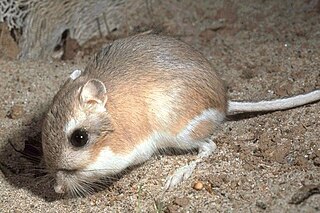
Kangaroo rats, small mostly nocturnal rodents of genus Dipodomys, are native to arid areas of western North America. The common name derives from their bipedal form. They hop in a manner similar to the much larger kangaroo, but developed this mode of locomotion independently, like several other clades of rodents.
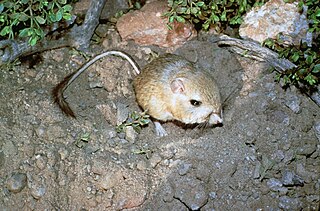
The giant kangaroo rat is an endangered species of heteromyid rodent endemic to California.
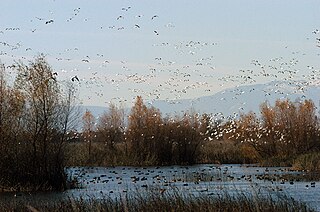
The California Central Valley grasslands is a temperate grasslands, savannas, and shrublands ecoregion in California's Central Valley. It a diverse ecoregion containing areas of desert grassland, prairie, savanna, riparian forest, marsh, several types of seasonal vernal pools, and large lakes such as now-dry Tulare Lake, Buena Vista Lake, and Kern Lake.

Heteromyidae is a family of rodents consisting of kangaroo rats, kangaroo mice, pocket mice and spiny pocket mice. Most heteromyids live in complex burrows within the deserts and grasslands of western North America, though species within the genus Heteromys are also found in forests and their range extends as far south as northern South America. They feed mostly on seeds and other plant parts, which they carry in their fur-lined cheek pouches to their burrows.
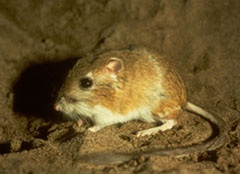
Ord's kangaroo rat is a kangaroo rat native to western North America, specifically the Great Plains and the Great Basin, with its range extending from extreme southern Canada to central Mexico.

The Morro Bay kangaroo rat, Dipodomys heermanni morroensis, is a rodent in the Heteromyidae family and endemic to San Luis Obispo County, California.
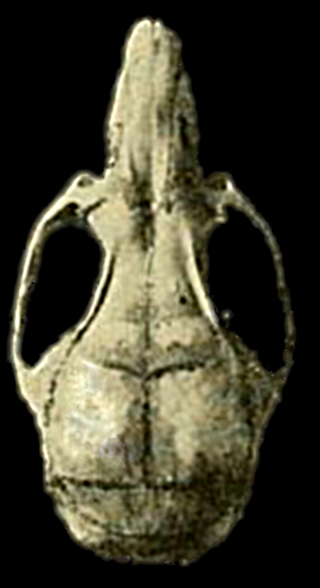
Transandinomys bolivaris, also known as the long-whiskered rice rat, is a rodent in the family Cricetidae. It is found in humid forest from northeastern Honduras to western Ecuador, up to 1,800 m (5,900 ft) above sea level. Since it was first described in 1901 from Ecuador, six scientific names have been introduced for it, but their common identity was not documented until 1998 and the species has long been known under the name Oryzomys bombycinus, described from Panama in 1912. The name Oryzomys bolivaris was used before it was moved to the new genus Transandinomys with Transandinomys talamancae in 2006.
The California kangaroo rat is a species of rodent in the family Heteromyidae. However, populations are declining, having not fully recovered after the drought in California from 2013 to 2015 destroyed their habitat and changed it into desert.

The desert kangaroo rat is a rodent species in the family Heteromyidae that is found in desert areas of southwestern North America. It is one of the large kangaroo rats, with a total length greater than 12 inches (300 mm) and a mass greater than 3.2 ounces (91 g).

The San Quintin kangaroo rat is a species of rodent in the family Heteromyidae. It is endemic to Mexico, where it is known only from western Baja California. Its natural habitat includes arid lowlands with sparse vegetation.

Heermann's kangaroo rat is a species of rodent in the family Heteromyidae. Their long smooth pelage resembles typical kangaroo rats, with their dorsal side showing a mixed range of olive, black and orange colors. There are 9 distinguished sub-species of Dipodomys heermanni: D.h. arenae, D.h. berkeleyensis, D.h. dixoni, D.h. goldmani, D.h. heermanni, D.h. jolonensis, D.h.morroensis, D.h. swarthi, and D.h. tularensis. The dental formula of Dipodomys heermanni is 1.0.1.31.0.1.3 × 2 = 20.
The San José Island kangaroo rat is a subspecies of rodent in the family Heteromyidae. It is endemic to Mexico, where it is found only on San José Island off the east coast of Baja California Sur. is restricted to an area of only 30 km2 in the southwestern coast of San José Island, Lower California, with the population having been drastically reduced in size and being close to extinction No other species of Dipodomys occur in sympatry with D. insularis.

Merriam's kangaroo rat is a species of rodent in the family Heteromyidae. The species name commemorates Clinton Hart Merriam. It is found in the Upper and Lower Sonoran life zones of the southwestern United States, Baja California, and northern Mexico.

The Fresno kangaroo rat or San Joaquin kangaroo rat is a species of rodent in the family Heteromyidae. It is endemic to areas within and near the San Joaquin Valley of California in the United States. Habitat destruction due to agricultural development and urbanization has put this species at risk, and the International Union for Conservation of Nature has assessed its conservation status as "vulnerable".

Stephens's kangaroo rat is a species of rodent in the family Heteromyidae. It is endemic to the Southern California region of the United States, primarily in western Riverside County. The species is named after American zoologist Frank Stephens (1849–1937).
The San Bernardino kangaroo rat is a species of rodent in the family Heteromyidae. It is one of 19 recognized subspecies of Merriam's kangaroo rat that are spread throughout the arid regions of the southwestern United States and Mexico.

Laurence Markham Huey (1892–1963) was an American zoologist and the Curator of Birds and Mammals at the San Diego Natural History Museum from 1923 to 1961. His main research field was the study of mammals and birds of California and Baja California. He also did field work on mammals and birds in Utah and Arizona, in particular at the Organ Pipe Cactus National Monument.
The big-eared kangaroo rat is a kangaroo rat that lives in chaparral. It is named for and distinguished by its comparatively large ears. It is usually considered a subspecies of the narrow-faced kangaroo rat, but it may be distinct. It is endemic to California in San Benito and Monterey counties.














